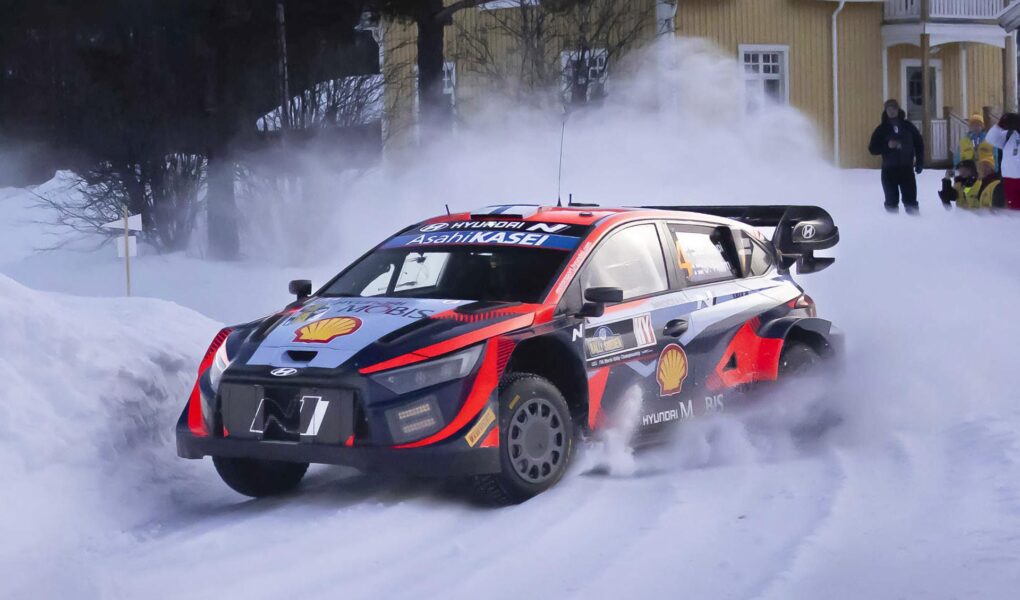Beneath the roar of engines and the scent of burning rubber lies a world where precision meets adrenaline—a realm where drivers navigate treacherous terrains at unthinkable speeds. Rally car racing, an exhilarating motorsport steeped in tradition and innovation, weaves through the rugged beauty of mountains, forests, and roads less traveled. It’s a dance between man and machine, where every twist and turn challenges the skill and courage of competitors. In this article, we will explore the origins of rally racing, the intricacies of its unique format, and the passionate community that surrounds this captivating sport. Join us as we delve into the heart-pounding world of rally car racing, uncovering the stories and science that fuel its enduring allure.
Table of Contents
- The Thrill of Off-Roading: Understanding the Unique Challenges of Rally Car Racing
- Essential Vehicle Modifications for Optimal Performance in Rally Events
- Mastering the Art of Navigation: The Role of Co-Drivers in Rally Success
- Preparing for Competition: Training Tips and Mental Strategies for Aspiring Rally Racers
- Q&A
- Final Thoughts
The Thrill of Off-Roading: Understanding the Unique Challenges of Rally Car Racing
The heart-pounding excitement of off-roading is steeped in a realm of unique challenges that set rally car racing apart from traditional motorsports. As drivers navigate through rugged terrains, they must be prepared to tackle a variety of unpredictable elements, such as mud, gravel, sand, and rocks. Unlike typical racetracks, which are designed for speed and precision, rally stages can range from bumpy countryside trails to treacherous mountain passes, each presenting an entirely new set of variables. To excel in this thrilling sport, a driver’s relentless focus, quick reflexes, and adaptive thinking become paramount, as every twist, turn, and obstacle demands an immediate strategic response.
Rally car racing also emphasizes the relationship between the driver and co-driver, a dynamic partnership that amplifies the competition’s intensity. The co-driver plays an essential role by providing real-time navigation through pace notes that detail the course in intricate patterns. This collaboration hinges on clear communication and seamless trust, vital for maintaining speed while executing complex maneuvers. To help illustrate the distinctiveness of rally car racing, consider these key aspects:
| Aspect | Rally Racing | Traditional Racing |
|---|---|---|
| Terrain | Varied (mud, gravel, snow) | Paved circuits |
| Co-driver Role | Essential for navigation | Absent or minimal |
| Race Format | Stages in different locations | Continuous laps on a track |
| Vehicle Setup | Specialized for off-road | Optimized for speed and grip |
Essential Vehicle Modifications for Optimal Performance in Rally Events
To elevate your rally car’s performance, several modifications are essential. First and foremost, enhancing the suspension system is crucial. A quality coilover kit can significantly improve handling on varying terrains. Additionally, the installation of reinforced skid plates protects the vehicle’s underbody during rough stages. Other notable upgrades include:
- Performance tires: Opt for tires designed for mixed terrains for better grip.
- Weight reduction: Removing unnecessary components can enhance speed and maneuverability.
- ECU tuning: A professional remap of the engine’s control unit maximizes power output.
Another vital aspect is the braking system. Upgrading to high-performance brake pads and larger rotors provides better stopping power, especially on steep declines. Furthermore, a reliable roll cage installation ensures driver safety and vehicle integrity during intense impacts. Below is a concise overview of these modifications:
| Modification | Purpose |
|---|---|
| Suspension Upgrade | Improved handling on diverse terrains |
| Performance Tires | Enhanced grip and traction |
| Weight Reduction | Increased speed and agility |
| Brake System Upgrade | Superior stopping power |
Mastering the Art of Navigation: The Role of Co-Drivers in Rally Success
In the exhilarating world of rally car racing, it’s easy to overlook the pivotal role played by co-drivers. These unsung heroes are more than just passengers; they are integral team members who bring a unique set of skills to the race. The dynamic between the driver and co-driver is founded on trust and communication, enabling them to navigate treacherous terrains at breakneck speeds. Co-drivers meticulously read pace notes, which help the driver anticipate turns and obstacles, enhancing their overall performance on the track. A well-coordinated team can often turn the tide of a competition, transforming mere speed into a finely-tuned execution of strategy and skill.
The responsibilities of a co-driver extend far beyond note-taking. They must possess an in-depth understanding of the course, adeptly manage time, and maintain a calm demeanor under pressure. Critical factors include:
- Pace Note Accuracy: Providing real-time feedback that dictates the driver’s actions.
- Route Familiarity: Knowing the terrain allows for better anticipation of challenges.
- Emotional Support: Maintaining morale and focus during the race.
To visualize the importance of a co-driver, consider this simple table demonstrating the impact of effective co-driving against poorly managed navigation:
| Factor | Effective Co-Driving | Poor Co-Driving |
|---|---|---|
| Communication | Clear and concise | Confusing or absent |
| Pace Note Clarity | Easy to understand | Ambiguous notes |
| Team Trust | High | Low |
| Race Strategy | Adaptable | Rigid |
Preparing for Competition: Training Tips and Mental Strategies for Aspiring Rally Racers
To excel in rally racing, a well-structured training regimen is essential. Start by building your driving skills through regular practice sessions on a variety of terrains. This helps you adapt to challenging conditions, enhancing your overall control and response when facing unexpected situations during a race. Incorporate the following elements into your practice routine:
- Time Trials: Set timed laps on different tracks to improve speed and consistency.
- Navigation Drills: Work closely with a co-driver to ensure smooth coordination and precise route navigation.
- Off-road Techniques: Practice various off-road maneuvers, focusing on maintaining momentum over obstacles.
Alongside physical training, fostering a robust mental game is equally important. The psychological aspect of racing can greatly influence your performance on the day of the event. Consider implementing these mental strategies:
- Visualization: Regularly visualize yourself racing, experiencing both the thrill and challenges ahead to build confidence.
- Mindfulness: Practice mindfulness techniques to enhance focus and reduce anxiety during intense moments on the track.
- Goal Setting: Define clear, achievable goals for each race, honing in on personal targets rather than just overall rankings.
Q&A
Q&A: Discovering the Thrills of Rally Car Racing
Q1: What is rally car racing?
A1: Rally car racing is a motorsport where drivers navigate off-road courses, often on mixed surfaces like gravel, dirt, tarmac, and snow. Unlike traditional racing formats, rally events take place over various terrains and are characterized by stage-based competition, where drivers race against the clock rather than directly against each other.
Q2: How does a rally event typically unfold?
A2: A rally event consists of multiple timed stages that can span anywhere from a few kilometers to several hundred. Each stage is preceded by a reconnaissance run where teams familiarize themselves with the route. After the stages, teams regroup for service stops where mechanics make repairs or adjustments. The cumulative time across all stages determines the winner.
Q3: What makes rally car racing unique compared to other motorsports?
A3: Rally car racing stands out due to its diverse terrains and unpredictable conditions. Unlike circuit racing, where tracks remain constant, rally routes change with each event and can vary significantly with weather conditions. The close collaboration between driver and co-driver also enhances the sport’s intricacies, as the co-driver provides crucial navigation notes to guide the driver through challenging sections.
Q4: What skills are essential for a successful rally driver?
A4: Successful rally drivers must possess exceptional car control, quick reflexes, and the ability to make split-second decisions. Familiarity with various driving techniques, such as drifting and managing oversteer, is vital. Physical fitness and mental stamina are equally important, as rally stages can last for long durations and require concentration throughout.
Q5: What role does the co-driver play in rally racing?
A5: The co-driver is an indispensable part of the rally team, responsible for navigating and providing real-time information to the driver. Using a specialized co-driver’s note system, they call out instructions, warn about obstacles, and relay the severity of turns ahead. This partnership is crucial, as effective communication can mean the difference between a successful run and a costly mistake.
Q6: Can anyone participate in rally car racing?
A6: Yes! Rally car racing is accessible to enthusiasts at various levels. While professional championships require specific licenses and compliance with regulations, amateur rallies allow drivers with less experience to compete. Many regions host entry-level events, offering classes for novice drivers and even special categories for traditional vehicles.
Q7: What are some notable rally competitions around the world?
A7: Some of the most prestigious rally competitions include the World Rally Championship (WRC), Dakar Rally, and the Monte Carlo Rally. Each event boasts its own unique characteristics, from the dynamic stages of WRC to the grueling endurance tests of the Dakar, captivating fans and competitors alike with their diverse challenges.
Q8: How can fans get involved with rally car racing?
A8: Fans can immerse themselves in rally car racing by attending local events, joining fan clubs, volunteering as marshals, or even participating in rally schools to learn the ropes. Rally festivals and exhibitions also offer opportunities to meet drivers, view vehicles up close, and experience the thrill of the sport first-hand.
Q9: What future trends are shaping rally car racing?
A9: The future of rally car racing is being influenced by advancements in technology, such as electric and hybrid vehicles, which are gradually making their way into the sport. Additionally, improved safety measures and environmental sustainability initiatives are becoming increasingly important. As the sport evolves, it remains committed to blending excitement with a responsible approach to motorsport.
Whether a seasoned fan or a curious newcomer, rally car racing offers a dynamic world of speed, skill, and teamwork—wrapped in the breathtaking tapestry of nature’s unpredictable canvas.
Final Thoughts
As the dust settles and the engines cool, the exhilarating world of rally car racing leaves us with more than just the roar of powerful engines and the thrill of tight turns. It embodies a unique blend of skill, strategy, and sheer determination that captivates both drivers and fans alike. From the winding forest trails to the rugged mountain passes, each stage of a rally event tells its own story, pushing teams to the limit as they navigate the unpredictable terrain.
Rally car racing is not merely about speed; it’s a dance between man, machine, and nature. It teaches valuable lessons in resilience, teamwork, and precision—qualities that resonate far beyond the finish line. Whether you’re a seasoned enthusiast or a curious newcomer, there’s no denying the magnetic allure of this sport that continuously evolves while honoring its roots. As we look to the future of rallying, one thing remains certain: the spirit of rally racing will endure, thrilling generations to come. So, buckle up and join us in celebrating a sport where every race writes a new chapter in the exhilarating saga of motorsport.



